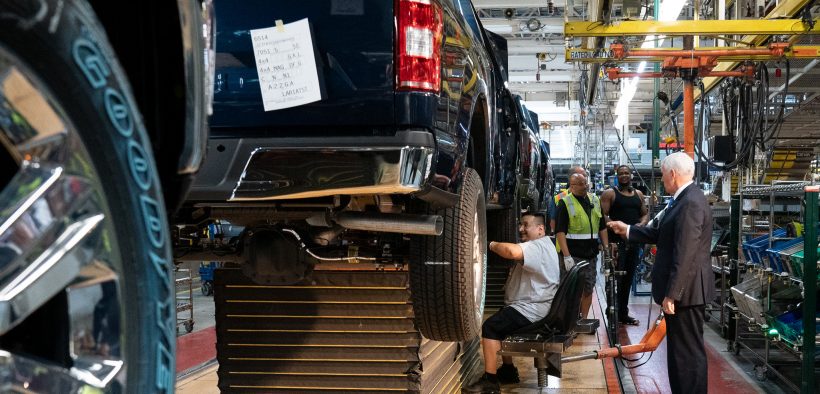China-US Tariff War Could Have Drastic Effects on Automotive Industry

If domestic automakers are unable to develop compelling environmentally friendly models, they are likely to lose market share, resulting in decreased exports and job losses in the United States.
According to a study commissioned by the Consumer Technology Association and the National Retail Federation, approximately 455,000 jobs are at risk from the latest escalation in the trade war between the United States and China. The recent $150 billion dollar retaliation tariffs by China in response to President Donald Trump’s raising of tariffs against the nation has increased tension.
“The American business community urges the Administration and the Chinese government to move forward expeditiously and in good faith to strike a high-standard, comprehensive, enforceable agreement, and end the tariffs now in place. Prolonging trade tensions and the escalation of tariffs are in neither country’s interest,” stated Myron Brilliant, Executive Vice President and Head of International Affairs, U.S. Chamber of Commerce regarding the current situation.
CNBC reported early on Monday concerning the ongoing trade war between the two nations:
“China will raise tariffs on $60 billion in U.S. goods in retaliation for the U.S. decision to hike duties on Chinese goods,” the Chinese Finance Ministry said Monday. “Beijing will increase tariffs on more than 5,000 products to as high as 25%. Duties on some other goods will increase to 20%. Those rates will rise from either 10% or 5% previously.”
The move follows President Donald Trump’s decision to raise duties on $200 billion in Chinese products to 25% from 10%. The world’s two largest economies have struggled to sign a trade deal and end a widening conflict that threatens to damage the global economy.
The continued standoff positions both China and the United States in a difficult situation. Yet, China may be better equipped to handle the evolving landscape regarding the automotive industries move to green energy.
China’s Move Away From Fossil Fuel Only Vehicles
Prior to the tariff war between the countries began to unfold, China began attempts to situate itself as a leader in electronic vehicle production. In September of 2017, Xin Guobin, China’s Vice Minister of Industry and Information Technology, announced regulators would be preparing a timeline to ban the sale and production of fossil fuel only vehicles. In March 2019, the Hainan province became the first to announce 2030 as the ban on fossil fuel only vehicles. If the announcement begins a pattern throughout China, the sale of fossil fuel only vehicles would end in approximately a decade.
Currently, the Chinese automotive market is the largest in the world, with sales of over 28 million vehicles in 2018 compared to 17 million in the United States. However, the market has been suffering as of late.
“Vehicles sales in China, the world’s largest auto market, fell 14.6% in April from the same month a year earlier, the country’s biggest auto industry association said on Monday, marking the 10th consecutive month of decline,” reports Reuters UK. “…Sales of new energy vehicles (NEV) have been a bright spot, rising 18.1% in April to 97,000 vehicles, CAAM said. NEV sales jumped almost 62 percent last year even as the broader auto market contracted,” the outlet later explained in relation to the “China VI” emission standards, which were enacted to combat climate change.
The nation has already restricted the sales of fossil fuel vehicles by banning the sale of over 500 models in 2018 from manufacturers including Mercedes Benz and General Motors. Several cities limit the sale of such vehicles through a yearly license plate lottery. Additionally, the government has required automakers to meet EV production quotas of approximately 3-4% in 2019.
If domestic automakers are unable to develop compelling environmentally friendly models, they are likely to lose market share, resulting in decreased exports and job losses in the United States. With conversations about the prospects of replacing fossil fuels with renewable energy, especially in relation to vehicles, keeping pace with Chinese manufacturers will be necessary for American manufacturers.
Challenges US Manufacturers Face
Legacy automakers face existential challenges as they lose their competitive advantage and are at a competitive disadvantage due to their lack of expertise in emerging technology. If there is a resistance to developing green vehicle technology, the United States car industry could see another disaster.
Possible high-quality and low-cost imports from China could pose a challenge to domestic automakers, much like the Japanese imports of the 1980s. Overcoming the conversion of changing technologies, loss of competitiveness and increased foreign competition will be a great challenge, especially in the aftermath of the 2009 bailout.
However, hope remains if domestic automakers are open to change. The transition into new automobile technologies offers the opportunity to obtain double-digit market share to companies that position themselves to take advantage of the altering landscape.
Federal and State governments should provide the necessary assistance during this transition period to increase competitiveness in the new technology and ensure exports, jobs and positive balances of trade. If these changes can be a part of Green New Deal proposals, domestic manufacturers will be able to compete with international competitors who are embracing green technology.







